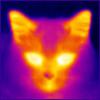A nanometer-sized superconducting quantum interference device (nanoSQUID) is fabricated on the apex of a sharp quartz tip and integrated into a scanning SQUID microscope. A simple self-aligned fabrication method results in nanoSQUIDs with diameters down to 100 nm with no lithographic processing. An aluminum nanoSQUID with an effective area of 0.034 μm2 displays flux sensitivity of 1.8 × 10−6 Φ0/Hz1/2 and operates in fields as high as 0.6 T. With projected spin sensitivity of 65 μB/Hz1/2 and high bandwidth, the SQUID on a tip is a highly promising probe for nanoscale magnetic imaging and spectroscopy.
http://pubs.acs.org/....1021/nl100009r

Edited by Cmyk Tyk, 10 September 2011 - 05:09 AM.












































